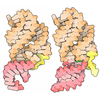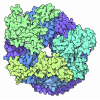+ Open data
Open data
- Basic information
Basic information
| Entry | Database: PDB / ID: 6zmw | ||||||||||||
|---|---|---|---|---|---|---|---|---|---|---|---|---|---|
| Title | Structure of a human 48S translational initiation complex | ||||||||||||
 Components Components |
| ||||||||||||
 Keywords Keywords | TRANSLATION / ribosome / initiation complex | ||||||||||||
| Function / homology |  Function and homology information Function and homology informationpositive regulation of eukaryotic translation initiation factor 4F complex assembly / : / male germ cell proliferation / positive regulation of mRNA binding / translation initiation ternary complex / regulation of translation in response to endoplasmic reticulum stress / positive regulation of translation in response to endoplasmic reticulum stress / glial limiting end-foot / HRI-mediated signaling / viral translational termination-reinitiation ...positive regulation of eukaryotic translation initiation factor 4F complex assembly / : / male germ cell proliferation / positive regulation of mRNA binding / translation initiation ternary complex / regulation of translation in response to endoplasmic reticulum stress / positive regulation of translation in response to endoplasmic reticulum stress / glial limiting end-foot / HRI-mediated signaling / viral translational termination-reinitiation / response to manganese-induced endoplasmic reticulum stress / Cellular response to mitochondrial stress / positive regulation of type B pancreatic cell apoptotic process / eukaryotic translation initiation factor 3 complex, eIF3e / Response of EIF2AK1 (HRI) to heme deficiency / Recycling of eIF2:GDP / negative regulation of translational initiation in response to stress / cap-dependent translational initiation / methionyl-initiator methionine tRNA binding / eukaryotic translation initiation factor 3 complex, eIF3m / Activation of the mRNA upon binding of the cap-binding complex and eIFs, and subsequent binding to 43S / PERK-mediated unfolded protein response / eukaryotic initiation factor 4E binding / PERK regulates gene expression / regulation of cellular response to stress / IRES-dependent viral translational initiation / response to kainic acid / translation reinitiation / eukaryotic translation initiation factor 2 complex / eukaryotic translation initiation factor 3 complex / nuclear stress granule / RNA cap binding / eukaryotic translation initiation factor 4F complex / formation of cytoplasmic translation initiation complex / cytoplasmic translational initiation / Z-decay: degradation of maternal mRNAs by zygotically expressed factors / multi-eIF complex / regulation of translational initiation in response to stress / eukaryotic 43S preinitiation complex / translation factor activity, RNA binding / mRNA cap binding / formation of translation preinitiation complex / Deadenylation of mRNA / miRNA-mediated gene silencing by inhibition of translation / eukaryotic 48S preinitiation complex / M-decay: degradation of maternal mRNAs by maternally stored factors / negative regulation of endoplasmic reticulum unfolded protein response / oxidized pyrimidine DNA binding / response to TNF agonist / positive regulation of base-excision repair / positive regulation of respiratory burst involved in inflammatory response / positive regulation of intrinsic apoptotic signaling pathway in response to DNA damage / positive regulation of gastrulation / protein tyrosine kinase inhibitor activity / positive regulation of endodeoxyribonuclease activity / IRE1-RACK1-PP2A complex / nucleolus organization / positive regulation of Golgi to plasma membrane protein transport / TNFR1-mediated ceramide production / negative regulation of DNA repair / negative regulation of RNA splicing / metal-dependent deubiquitinase activity / supercoiled DNA binding / neural crest cell differentiation / protein-synthesizing GTPase / NF-kappaB complex / nuclear-transcribed mRNA catabolic process, nonsense-mediated decay / cysteine-type endopeptidase activator activity involved in apoptotic process / regulation of translational initiation / oxidized purine DNA binding / positive regulation of ubiquitin-protein transferase activity / positive regulation of protein localization to cell periphery / negative regulation of intrinsic apoptotic signaling pathway in response to hydrogen peroxide / regulation of establishment of cell polarity / negative regulation of bicellular tight junction assembly / ubiquitin-like protein conjugating enzyme binding / negative regulation of phagocytosis / rRNA modification in the nucleus and cytosol / Formation of the ternary complex, and subsequently, the 43S complex / erythrocyte homeostasis / cytoplasmic side of rough endoplasmic reticulum membrane / laminin receptor activity / negative regulation of ubiquitin protein ligase activity / protein kinase A binding / ion channel inhibitor activity / Ribosomal scanning and start codon recognition / pigmentation / Translation initiation complex formation / positive regulation of mitochondrial depolarization / positive regulation of T cell receptor signaling pathway / negative regulation of Wnt signaling pathway / fibroblast growth factor binding / monocyte chemotaxis / positive regulation of activated T cell proliferation / positive regulation of protein metabolic process / negative regulation of translational frameshifting / TOR signaling / Protein hydroxylation / BH3 domain binding / SARS-CoV-1 modulates host translation machinery Similarity search - Function | ||||||||||||
| Biological species |  Homo sapiens (human) Homo sapiens (human) | ||||||||||||
| Method | ELECTRON MICROSCOPY / single particle reconstruction / cryo EM / Resolution: 3.7 Å | ||||||||||||
 Authors Authors | Brito Querido, J. / Sokabe, M. / Kraatz, S. / Gordiyenko, Y. / Skehel, M. / Fraser, C. / Ramakrishnan, V. | ||||||||||||
| Funding support |  United Kingdom, United Kingdom,  United States, 3items United States, 3items
| ||||||||||||
 Citation Citation |  Journal: Science / Year: 2020 Journal: Science / Year: 2020Title: Structure of a human 48 translational initiation complex. Authors: Jailson Brito Querido / Masaaki Sokabe / Sebastian Kraatz / Yuliya Gordiyenko / J Mark Skehel / Christopher S Fraser / V Ramakrishnan /   Abstract: A key step in translational initiation is the recruitment of the 43 preinitiation complex by the cap-binding complex [eukaryotic initiation factor 4F (eIF4F)] at the 5' end of messenger RNA (mRNA) to ...A key step in translational initiation is the recruitment of the 43 preinitiation complex by the cap-binding complex [eukaryotic initiation factor 4F (eIF4F)] at the 5' end of messenger RNA (mRNA) to form the 48 initiation complex (i.e., the 48). The 48 then scans along the mRNA to locate a start codon. To understand the mechanisms involved, we used cryo-electron microscopy to determine the structure of a reconstituted human 48 The structure reveals insights into early events of translation initiation complex assembly, as well as how eIF4F interacts with subunits of eIF3 near the mRNA exit channel in the 43 The location of eIF4F is consistent with a slotting model of mRNA recruitment and suggests that downstream mRNA is unwound at least in part by being "pulled" through the 40 subunit during scanning. | ||||||||||||
| History |
|
- Structure visualization
Structure visualization
| Movie |
 Movie viewer Movie viewer |
|---|---|
| Structure viewer | Molecule:  Molmil Molmil Jmol/JSmol Jmol/JSmol |
- Downloads & links
Downloads & links
- Download
Download
| PDBx/mmCIF format |  6zmw.cif.gz 6zmw.cif.gz | 2.7 MB | Display |  PDBx/mmCIF format PDBx/mmCIF format |
|---|---|---|---|---|
| PDB format |  pdb6zmw.ent.gz pdb6zmw.ent.gz | Display |  PDB format PDB format | |
| PDBx/mmJSON format |  6zmw.json.gz 6zmw.json.gz | Tree view |  PDBx/mmJSON format PDBx/mmJSON format | |
| Others |  Other downloads Other downloads |
-Validation report
| Summary document |  6zmw_validation.pdf.gz 6zmw_validation.pdf.gz | 261.5 KB | Display |  wwPDB validaton report wwPDB validaton report |
|---|---|---|---|---|
| Full document |  6zmw_full_validation.pdf.gz 6zmw_full_validation.pdf.gz | 265 KB | Display | |
| Data in XML |  6zmw_validation.xml.gz 6zmw_validation.xml.gz | 124.7 KB | Display | |
| Data in CIF |  6zmw_validation.cif.gz 6zmw_validation.cif.gz | 205.3 KB | Display | |
| Arichive directory |  https://data.pdbj.org/pub/pdb/validation_reports/zm/6zmw https://data.pdbj.org/pub/pdb/validation_reports/zm/6zmw ftp://data.pdbj.org/pub/pdb/validation_reports/zm/6zmw ftp://data.pdbj.org/pub/pdb/validation_reports/zm/6zmw | HTTPS FTP |
-Related structure data
| Related structure data |  11302MC  6ybdC  6ybsC  6ybtC  6ybvC  6ybwC C: citing same article ( M: map data used to model this data |
|---|---|
| Similar structure data |
- Links
Links
- Assembly
Assembly
| Deposited unit | 
|
|---|---|
| 1 |
|
- Components
Components
-Eukaryotic translation initiation factor ... , 19 types, 19 molecules 2164uvy8x35ropqzstg
| #1: Protein | Mass: 36543.773 Da / Num. of mol.: 1 / Source method: isolated from a natural source / Source: (natural)  Homo sapiens (human) / References: UniProt: Q13347 Homo sapiens (human) / References: UniProt: Q13347 |
|---|---|
| #2: Protein | Mass: 92593.414 Da / Num. of mol.: 1 / Source method: isolated from a natural source / Source: (natural)  Homo sapiens (human) / References: UniProt: P55884 Homo sapiens (human) / References: UniProt: P55884 |
| #3: Protein | Mass: 42555.832 Da / Num. of mol.: 1 / Source method: isolated from a natural source / Source: (natural)  Homo sapiens (human) / References: UniProt: Q7L2H7 Homo sapiens (human) / References: UniProt: Q7L2H7 |
| #4: Protein | Mass: 37593.645 Da / Num. of mol.: 1 / Source method: isolated from a natural source / Source: (natural)  Homo sapiens (human) / References: UniProt: O00303, ubiquitinyl hydrolase 1 Homo sapiens (human) / References: UniProt: O00303, ubiquitinyl hydrolase 1 |
| #5: Protein | Mass: 166903.781 Da / Num. of mol.: 1 / Source method: isolated from a natural source / Source: (natural)  Homo sapiens (human) / References: UniProt: Q14152 Homo sapiens (human) / References: UniProt: Q14152 |
| #6: Protein | Mass: 52281.633 Da / Num. of mol.: 1 / Source method: isolated from a natural source / Source: (natural)  Homo sapiens (human) / References: UniProt: P60228 Homo sapiens (human) / References: UniProt: P60228 |
| #8: Protein | Mass: 105503.945 Da / Num. of mol.: 1 / Source method: isolated from a natural source / Source: (natural)  Homo sapiens (human) / References: UniProt: Q99613 Homo sapiens (human) / References: UniProt: Q99613 |
| #9: Protein | Mass: 39979.277 Da / Num. of mol.: 1 / Source method: isolated from a natural source / Source: (natural)  Homo sapiens (human) / References: UniProt: O15372 Homo sapiens (human) / References: UniProt: O15372 |
| #19: Protein | Mass: 64060.758 Da / Num. of mol.: 1 / Source method: isolated from a natural source / Source: (natural)  Homo sapiens (human) / References: UniProt: O15371 Homo sapiens (human) / References: UniProt: O15371 |
| #20: Protein | Mass: 25083.619 Da / Num. of mol.: 1 / Source method: isolated from a natural source / Source: (natural)  Homo sapiens (human) / References: UniProt: Q9UBQ5 Homo sapiens (human) / References: UniProt: Q9UBQ5 |
| #21: Protein | Mass: 66803.734 Da / Num. of mol.: 1 / Source method: isolated from a natural source / Source: (natural)  Homo sapiens (human) / References: UniProt: Q9Y262 Homo sapiens (human) / References: UniProt: Q9Y262 |
| #30: Protein | Mass: 36161.180 Da / Num. of mol.: 1 / Source method: isolated from a natural source / Source: (natural)  Homo sapiens (human) / References: UniProt: P05198 Homo sapiens (human) / References: UniProt: P05198 |
| #47: Protein | Mass: 35662.016 Da / Num. of mol.: 1 / Source method: isolated from a natural source / Source: (natural)  Homo sapiens (human) / References: UniProt: O75821 Homo sapiens (human) / References: UniProt: O75821 |
| #48: Protein | Mass: 12752.498 Da / Num. of mol.: 1 Source method: isolated from a genetically manipulated source Source: (gene. exp.)  Homo sapiens (human) / Gene: EIF1, SUI1 / Production host: Homo sapiens (human) / Gene: EIF1, SUI1 / Production host:  |
| #49: Protein | Mass: 16488.449 Da / Num. of mol.: 1 Source method: isolated from a genetically manipulated source Source: (gene. exp.)  Homo sapiens (human) / Gene: EIF1AX, EIF1A, EIF4C / Production host: Homo sapiens (human) / Gene: EIF1AX, EIF1A, EIF4C / Production host:  |
| #50: Protein | Mass: 29108.453 Da / Num. of mol.: 1 Source method: isolated from a genetically manipulated source Source: (gene. exp.)  Homo sapiens (human) / Gene: EIF3J, EIF3S1, PRO0391 / Production host: Homo sapiens (human) / Gene: EIF3J, EIF3S1, PRO0391 / Production host:  |
| #53: Protein | Mass: 38454.484 Da / Num. of mol.: 1 / Source method: isolated from a natural source / Source: (natural)  Homo sapiens (human) / References: UniProt: P20042 Homo sapiens (human) / References: UniProt: P20042 |
| #55: Protein | Mass: 51178.406 Da / Num. of mol.: 1 / Source method: isolated from a natural source / Source: (natural)  Homo sapiens (human) / References: UniProt: P41091, protein-synthesizing GTPase Homo sapiens (human) / References: UniProt: P41091, protein-synthesizing GTPase |
| #57: Protein | Mass: 145733.172 Da / Num. of mol.: 1 Source method: isolated from a genetically manipulated source Source: (gene. exp.)  Homo sapiens (human) / Gene: EIF4G1, EIF4F, EIF4G, EIF4GI / Production host: Homo sapiens (human) / Gene: EIF4G1, EIF4F, EIF4G, EIF4GI / Production host:  |
+40S ribosomal protein ... , 31 types, 31 molecules SGHKLONQPIBCDEFJRTVYZabdefimnMh
-RNA chain , 3 types, 3 molecules 7Aw
| #22: RNA chain | Mass: 9172.806 Da / Num. of mol.: 1 Source method: isolated from a genetically manipulated source Source: (gene. exp.)  Homo sapiens (human) / Production host: Homo sapiens (human) / Production host:  |
|---|---|
| #24: RNA chain | Mass: 603130.375 Da / Num. of mol.: 1 / Source method: isolated from a natural source / Source: (natural)  Homo sapiens (human) Homo sapiens (human) |
| #54: RNA chain | Mass: 24231.510 Da / Num. of mol.: 1 / Source method: isolated from a natural source / Source: (natural)  Homo sapiens (human) / References: GenBank: 174924 Homo sapiens (human) / References: GenBank: 174924 |
-Protein/peptide , 1 types, 1 molecules 9
| #23: Protein/peptide | Mass: 3473.451 Da / Num. of mol.: 1 / Source method: isolated from a natural source / Source: (natural)  Homo sapiens (human) / References: UniProt: P62945 Homo sapiens (human) / References: UniProt: P62945 |
|---|
-Protein , 3 types, 3 molecules ckj
| #39: Protein | Mass: 35115.652 Da / Num. of mol.: 1 / Source method: isolated from a natural source / Source: (natural)  Homo sapiens (human) / References: UniProt: P63244 Homo sapiens (human) / References: UniProt: P63244 |
|---|---|
| #44: Protein | Mass: 18004.041 Da / Num. of mol.: 1 / Source method: isolated from a natural source / Source: (natural)  Homo sapiens (human) / References: UniProt: P62979 Homo sapiens (human) / References: UniProt: P62979 |
| #56: Protein | Mass: 46207.824 Da / Num. of mol.: 1 Source method: isolated from a genetically manipulated source Source: (gene. exp.)  Homo sapiens (human) / Gene: EIF4A1, DDX2A, EIF4A / Production host: Homo sapiens (human) / Gene: EIF4A1, DDX2A, EIF4A / Production host:  |
-Non-polymers , 2 types, 91 molecules 


| #58: Chemical | | #59: Chemical | ChemComp-MG / |
|---|
-Details
| Has ligand of interest | Y |
|---|
-Experimental details
-Experiment
| Experiment | Method: ELECTRON MICROSCOPY |
|---|---|
| EM experiment | Aggregation state: PARTICLE / 3D reconstruction method: single particle reconstruction |
- Sample preparation
Sample preparation
| Component |
| ||||||||||||||||||||||||
|---|---|---|---|---|---|---|---|---|---|---|---|---|---|---|---|---|---|---|---|---|---|---|---|---|---|
| Source (natural) |
| ||||||||||||||||||||||||
| Source (recombinant) | Organism:  | ||||||||||||||||||||||||
| Buffer solution | pH: 7.4 | ||||||||||||||||||||||||
| Specimen | Embedding applied: NO / Shadowing applied: NO / Staining applied: NO / Vitrification applied: YES | ||||||||||||||||||||||||
| Specimen support | Grid material: COPPER / Grid mesh size: 400 divisions/in. / Grid type: Quantifoil | ||||||||||||||||||||||||
| Vitrification | Instrument: FEI VITROBOT MARK IV / Cryogen name: ETHANE / Humidity: 100 % |
- Electron microscopy imaging
Electron microscopy imaging
| Experimental equipment |  Model: Titan Krios / Image courtesy: FEI Company |
|---|---|
| Microscopy | Model: FEI TITAN KRIOS |
| Electron gun | Electron source:  FIELD EMISSION GUN / Accelerating voltage: 300 kV / Illumination mode: FLOOD BEAM FIELD EMISSION GUN / Accelerating voltage: 300 kV / Illumination mode: FLOOD BEAM |
| Electron lens | Mode: BRIGHT FIELD |
| Image recording | Average exposure time: 1 sec. / Electron dose: 107 e/Å2 / Detector mode: INTEGRATING / Film or detector model: FEI FALCON III (4k x 4k) |
- Processing
Processing
| Software |
| ||||||||||||||||||||||||
|---|---|---|---|---|---|---|---|---|---|---|---|---|---|---|---|---|---|---|---|---|---|---|---|---|---|
| CTF correction | Type: PHASE FLIPPING AND AMPLITUDE CORRECTION | ||||||||||||||||||||||||
| 3D reconstruction | Resolution: 3.7 Å / Resolution method: FSC 0.143 CUT-OFF / Num. of particles: 37870 / Symmetry type: POINT | ||||||||||||||||||||||||
| Refinement | Cross valid method: NONE Stereochemistry target values: GeoStd + Monomer Library + CDL v1.2 | ||||||||||||||||||||||||
| Displacement parameters | Biso mean: 100.73 Å2 | ||||||||||||||||||||||||
| Refine LS restraints |
|
 Movie
Movie Controller
Controller








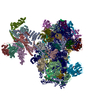


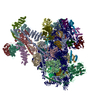
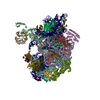
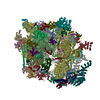

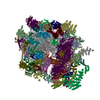
 PDBj
PDBj












